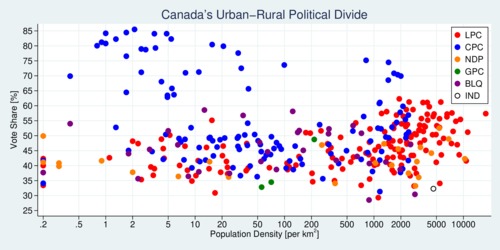Canada elected a new parliament on October 21. The vote revealed a widening urban-rural gap. As has been widely reported, including by Les Perreaux in the Globe and Mail, Canada's divisions have been thrown into sharp relief. Nowhere is this more obvious than the concentration of political support for the Conservatives in rural areas and support for the Liberals in urban areas.
The diagram below, compiled from preliminary election results from Elections Canada and election district summary statistics from Statistics Canada, highlights the strong correlation between political support and population density.

click on image for high-resolution PDF version
The diagram shows which party won a riding through the colour of each dot: red for Liberals (LPC), blue for Conservatives (CPC), orange for the NDP, green for the Green party (GPC), and purple for the Bloc Québécois. The hollow black circle is for the single independent winner in Vancouver Granville. The horizontal axis shows the population density on a logarithmic scale, and the vertical axis shows the vote share with which a riding was won. A few ridings (in particular the Norther territories) were grouped on the left side of the diagram with a censored 0.2 population density, for convenience of exposition.
The diagram shows clusters of blue dots on the left, and no blue dots exceed a population density of larger than about 2,500. All the urban ridings with larger population densities were won by Liberal and NDP candidates. While Liberals and NDP candidates did win rural ridings as well, the bulk of their wins were in urban ridings.
| Population Density (per km2) | Vote Share Density Effect |
|||
|---|---|---|---|---|
| Mean | Median | Maximum | ||
| Liberal Party of Canada | 2,299 | 1,545 | 17,785 | +2.57*** |
| Conservative Party of Canada | 456 | 40 | 2,442 | –2.46*** |
| National Democratic Party | 2,012 | 1,167 | 10,371 | 0.22 |
The median population density for the 157 Liberal ridings is more than 38 times higher than for the 121 Conservative ridings; the ratio for the mean is still 5 times higher. The NDP's 24 ridings are distributed similarly to the Liberal ridings.
There is also a vote share correlation. Perhaps it is a unique "prairies effect", but Conservative vote shares decline with population density (about 1.7%-points when population density doubles), while Liberal vote shares increase with population density (about 1.8%-points when population density doubles). This simple log-linear regression analysis includes ridings all 338 ridings.
The diagram also shows why Canada's first-past-the-post electoral system delivered a more efficient outcome for the Liberals but not for the Conservatives. Conservative ridings were won with large margins, whereas Liberal ridings were mostly won with small margins. As a result, Liberals won more ridings than the Conservatives despite a slightly smaller share of the popular vote.
The urban-rural divide is not unique to Canada. As Emily Badger reported in May 2019 in the New York Times "How the Rural-Urban Divide Became America's Political Fault Line", this division has profound consequences. Political polarization along urban-rural lines has also arrived in Canada.
There are some hard lessons for Conservatives and Liberals alike. For Conservatives to gain electoral success, they cannot solely rely on attracting socially-conservative voters from rural areas across the Prairie provinces. Their political program needs to appeal to the middle as well (and those that are worried about climate change), or they will remain perpetually stuck in the one-third support that they received a few days ago in the 2019 election. On the other hand, Liberals cannot simply give up on rural ridings either. While Liberals won't attract socially-conservative voters, they need to appeal to economically-motivated voters in rural areas with programs that address their economic fears and employment challenges. The structural change hitting many resource-dependent areas of the country will require policies that help people adapt to these challenges through skill upgrading, mobility, and a social safety net that insulates against the worst of these economic shocks.
Canada's first-past-the-post electoral system may well be aggravating the urban-rural divide. Alberta and Saskatchewan are left with no Liberal representatives in parliament and in government, and thus no immediate "voice at the cabinet table" to raise their regional concerns. And the roughly one-third of voters in Saskatchewan and Alberta who did not vote Conservative have no voice in parliament either. Electoral reform may well help ensure more diverse regional representation across the political spectrum.
Further readings:
- After the election, can Justin Trudeau unite Canada?, The Economist, October 22, 2019.
- Les Perreaux: Federal election 2019: Canada's divisions have been thrown into sharp relief, The Globe and Mail, October 21, 2019.
- Henry Olsen: The urban-rural divide is defining politics worldwide. Canada's election is proof., The Washington Post, October 22, 2019.
![[Sauder School of Business]](logo-ubc-sauder-2016.png)
![[The University of British Columbia]](logo-ubc-2016.png)